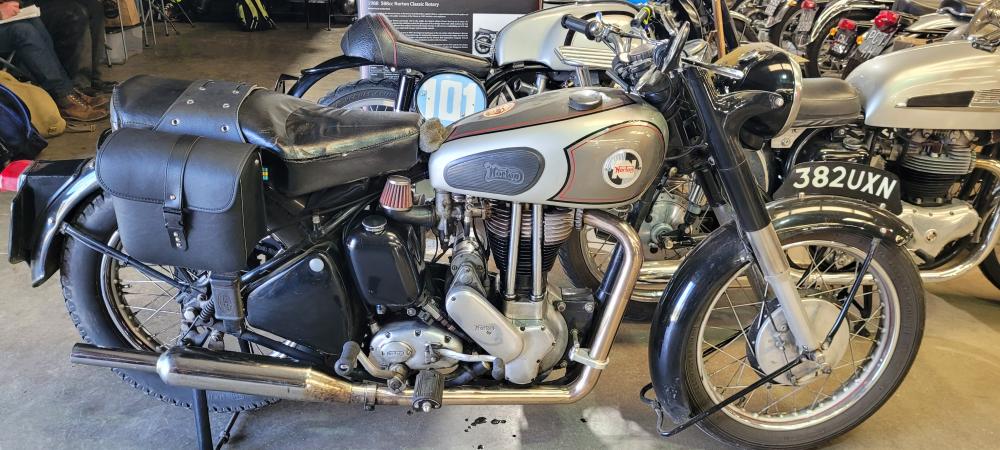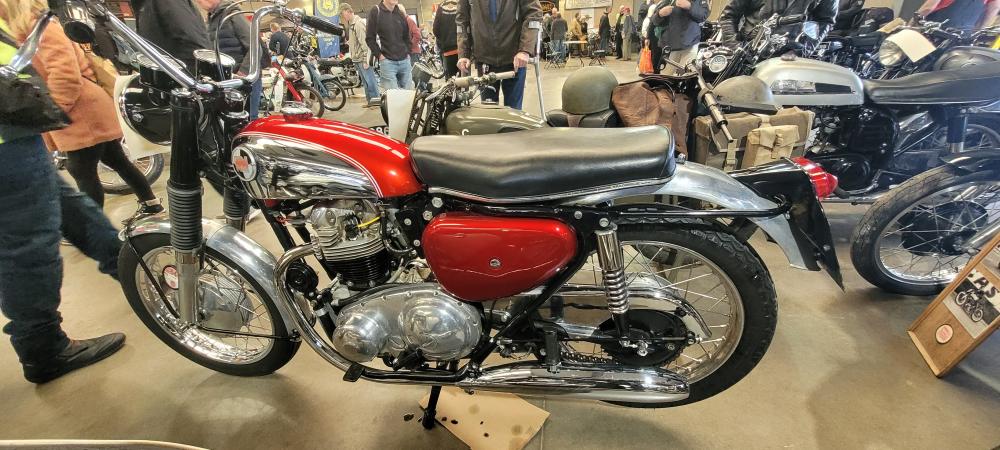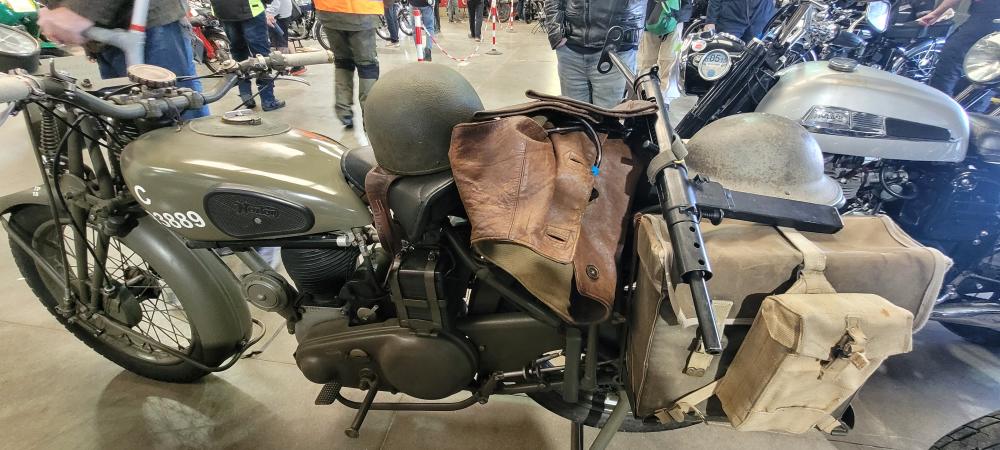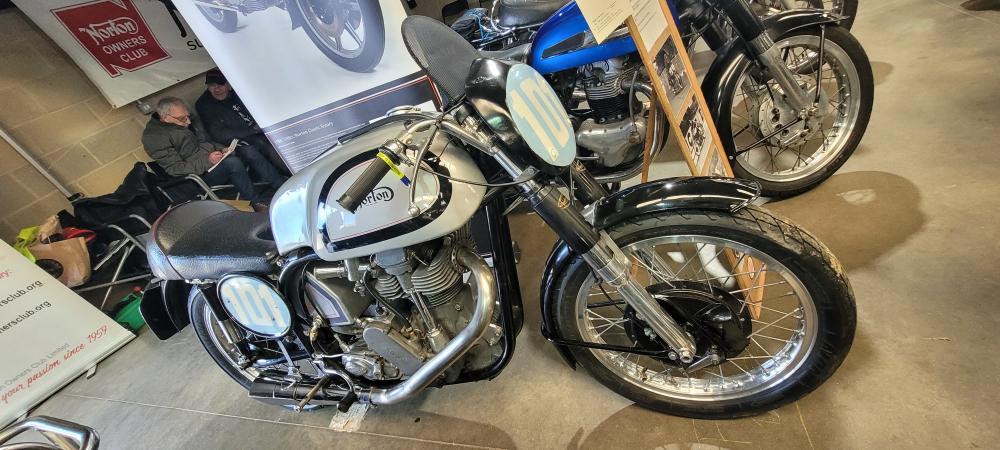Various authors from Roadholder and NOC-L
Just the start on the very involved subject of the Commando clutch; with a huge amount of correspondence from the NOC-L mailing list still to be edited down and included
Gear oil in the clutch
|
..... the oil has to climb all the way up to the clutch lifter body, or come through the ball bearing, then find its way through the slot, past the ball and squeeze itself past the pushrod all the way down the mainshaft. |
A remedy using a gearbox breather
These problems ceased on my bike when I improved the breathing to the gearbox by installing a Mk.lll quality breather. I didn't use the actual Mk.lll part, but just drilled the inner cover near where the clutch cable comes out and installed a small piece of thin copper tubing (about 1/8" i.d.), bent on top like the crook of a cane to keep water from getting in. My intention in doing this was to reduce the amount of moisture remaining in the gear oil from condensation and also to let me plug the hole in the inspection cap which let in rain. Never smelling gear-oil in my primary again was a happy bonus, because I was planning to do the ball-bearing-in-the-pushrod modification, which would have been much more work.
Mike Taglieri (miketnyc@aol.com) on NOC-L 6th. May 1997
Ideas as to how the oil migrates
Oil can't reach the clutch lifter body by itself. As there are no rotating parts in low positions to the right of the inner case (kickstarter case) that could lift the oil up, oil will have to be transported by other means. In fact there is only one spinning part between the covers - the mainshaft nut outside the ball bearing - located pretty high up. So, the only other way of getting liquid oil there is by splashing oil inside the shell that has an impact with the rotating balls, gets displaced through the ball bearing, and flings against the internal surfaces of the clutch lifter body, from where it drains. The rotating nut will throw some of it around but primarily in a radial direction.
To have oil at the protruding pressure rod, it has to flow from the nut or flow along the lifter body ceiling and drip from there. Due to surface tension and centrifugal force, oil flow will happen only at low r.p.m., but even then, the amount of oil reaching the rod and end of the mainshaft is probably extremely small.
A scenario more convincing to me is the existence of oil mist and pressure. We know that oil gets sloshed around and we also know that the gearbox heats up due to friction and mechanical deformation, causing rising pressure according to the laws of thermodynamics. Some of the oil will evaporate and become an oil mist, the pressure tries to balance and forces internal gas (here = oil mist) to travel in the direction of ambient pressure, which is in the primary chaincase. On its way there, the gas/mist may or may not cool and condense. If it doesn't, dispersion inside the clutch is even more perfect; if it condenses, centrifugal forces eventually disperses the oil dropwise and although contamination may take more time, it happens.
With this scenario, rate of transport/contamination should be proportional to strain on the gearbox. The harder you drive, the more heat is produced, and the more mist is generated and transported. Furthermore, as power input is a factor in the equation, a single or 500-600 cc twin should be less affected than the 650/750/850s.
If this model is correct, there are three ways to stop contamination by technical means:-
- By reduction of pressure inside the gearbox. The Mk.lll way is sensible, but by venting to the inlet manifold or air filter box a pressure lower than ambient could be generated.
- By promotion of cooling of the gearbox. This is achieved by fitting a bigger sump and/or a cooler along with pressure lubrication - common feature on powerful modern bikes.
- By plugging the gap between clutch pressure rod and mainshaft bore ('O' ring option). This solution is not going to work well due to lack of mating surfaces and will therefore leak. Positive pressure will ensure the 'O' ring is squeezed against the mainshaft, but lack of pressure (when the gearbox is cold and at low loads) may bring it out of position, and there is no way of bringing it back into seating. A dedicated seal between the mainshaft and the clutch lifter body, similar to the timing side crank shaft and timing cover, would have to be engineered.
Knut Soensteby (knut.sonsteby@lhg.hib.no) on NOC-L 9th. May 1997
A remedy using 'O' rings
I machine two 'O' ring grooves in the pushrod, one 40mm from each end. The grooves are 0.75mm deep x 1.5mm wide. The 'O' rings are quite small, and will have to be stretched over the rod into the groove. I haven't mentioned the 'O' ring size as you will have to try a few sizes to get the correct fit in your main shaft. It's got to be a light push fit to ensure the pushrod returns fully and won't upset the clutch.
The point is that the 'O' rings are inside the main shaft, and seal on the bore as all good 'O' rings are meant to. The modification does work, I'm running it with my dry belt, and I checked it yesterday. The section of unsealed rod was swamped with oil, whilst the sealed end and clutch were dry.
One 'O' ring will work, but I prefer two as they centre the push rod. For all you chaps out there who haven't access to a lathe, the first time I did it, I fitted two hacksaw blades into my hacksaw, put the pushrod into an electric drill that was clamped into a vice, and with the drill running, hand cut the grooves.
Dave Taylor(lsd.taylor2@)virgin.net on NOC-L 10th. May 1997
A remedy using a bearing
The first gear pair, as it meshes, pumps oil through the main shaft bearing into the clutch lifter body, and the oil finds its way into the clutch through the main shaft. Some Commandos have that problem, and some don't, because some bearings carry more balls than others.
The solution is to find a double sealed bearing (heavy duty of course), pop out one seal and install it with the open side towards the gears; that should do it. My 6-speed gearbox has different size gears and therefore I do not have these problems. The ball locates the lifter lever correctly and once the pushrod is in place, the ramp and roller move it to release the clutch. The pushrod travel is about right, but it depends on the shape of the ramp.
Heinz Kegler (ytnh94a@prodigy.com) on NOC-L 10th. May 1997
Another remedy
My solution to this problem was to fashion a seal out of a felt disk I had lying around and cut a hole in it for the clutch pushrod to come through but still fit snugly. I mounted the seal at the clutch end of the mainshaft and kept it in place with a light spring installed between the seal and the adjustment nut. It worked quite well.
Tom Allen (thomasa@halcyon.com) on NOC-L 11th. May 1997
Some lateral thinking on the problem
I have read with interest the long thread regarding gearbox oil migrating along the clutch pushrod and ending up at the clutch hub, only to be centrifuged across the clutch plates, contaminating them and messing up the clutch. The theories as to how the oil manages to make this journey, as well as the ingenious fixes (ranging from 'O'-rings, severed rods with ball bearings, lipped oil seals, sealed bearings, felt seals, and even depressurising the gearbox) have certainly demonstrated the creative talents of the list members. I think however, it may be time for some lateral thinking here.
If hypoid oil is causing such a problem with the clutch plates, then why not use a lubricant in the gearbox which will not foul up the clutch when it migrates there? The Commando transmission is not particularly demanding in its lubrication requirements, since it consists of straight-cut gears, bushes, ball and roller bearings. There is a need for corrosion inhibitors since short rides don't warm it up very much, and the breather hole in the inspection cover probably lets in as much moisture when riding in the rain as it lets out the rest of the time. Other than that, it's pretty basic stuff.
I have been using outboard motor lower unit oil in my Commando gearbox for the past 25,000 miles or so, and have had no problems with the transmission or clutch since making the switch. This stuff is a top-rate lubricant with added corrosion inhibitors and designed to operate in a fairly hostile environment (it doesn't get really warm when running under water for short periods of time) and is used to protect a drivetrain consisting of bevel gears running under pretty high pressures.
I would also like to propose another solution to the list, although I cannot personally vouch for it. Back in the early 1970s when I was drag racing Kawasaki H1s, the factory-recommended transmission lubricant was ATF. Since ATF works so well in the Commando primary (I will vouch for that!), what would be the problem with running it in the gearbox as well? If it performed well in those H1 transmissions with the abuse they were enduring, it surely would be adequate for a Commando.
Stan Smith (sks3rd@aol.com) on NOC-L 11th. May 1997
Remedy for clutch spring loss of efficiency
Tim Stevens has explained in the Service Notes that optimum clamping force is obtained with the diaphragm spring compressed just beyond its flat point. This allows slight wear of the clutch plates to cause the spring to become more flat and actually increases the clamping force.
The problem is that pretty soon after the maximum has been achieved, further wear causes the spring to become concave and the clamping load drops off rapidly.
There are two remedies for this. A new set of friction plates, almost twenty quids worth, or some form of packing to take up the combined loss of plate thickness. An ideal item to pack the clutch with is an extra plain steel plate, but this is likely to be far too thick.
Alan Bromkew in RH 105 - Sep/Oct 1982
ATF as primary chaincase fluid to prevent clutch slip
When the clutch on my stock 850 Commando began to slip at high r.p.m. (it has the bronze metal plates) and no amount of adjustment seemed to cure the problem, I assumed a new clutch was in order. At the advice of a local Norton shop, I did the following to the bike which quickly (and cheaply) remedied the trouble:
- Empty the oil from the primary chaincase (simply loosen the centre nut on pre -'75 models) and let it drain into a pan
- Retighten chaincase and fill with about 1/2 pint kerosene
- Start the bike and runs for about 10 minutes, disengaging the clutch and revving up several times to cleanse the plates
- Empty the chaincase as in 1. above
- Tighten up and refill with automatic transmission fluid
This procedure has proved quite satisfactory for my machine, and no more clutch slip. I used Ford ATF in mine, but I'm not sure if this is a factor.
Brian Moran in RH 120 - Mar/Apr 1985
Clutch spring calculations
It was suggested that adding an extra plain plate into a Commando clutch would result in easier clutch lever action, but that it may also result in a clutch slip problem.
For information - assuming a Commando clutch fitted with a new diaphragm spring which has been correctly set up with the clutch fully engaged -
- It will reduce the load required at the spring centre to free off the clutch to approximately 62% of its original value. Thus, it would result in easier clutch lever action.
- It will reduce the load the spring applies to the clutch friction interfaces with the clutch fully engaged to approximately 62% of its original value. As one of the factors used to calculate the amount of torque a fully engaged clutch will 'carry' before slip occurs is the value of this clamping load, it follows that the addition of an extra 2mm thick plain plate will reduce the amount of torque the fully engaged clutch will carry before slip occurs to approximately 62% of its original value.
This is of course as clever a shoving a few fingers between a fast moving chain and sprocket or putting a dry clutch inside an oil bath chaincase, which is what Norton did .....
|
Note:- If you have fitted a 0.050" (1.25mm) thicker pressure plate to your Commando clutch, replace the spring load mentioned above of approximately 62%, with approximately 75%. |
J.M. Leadbeter in RH 181 - May/Jun 1995








